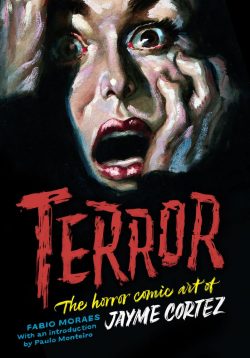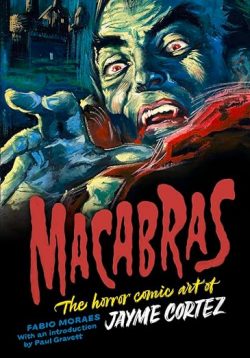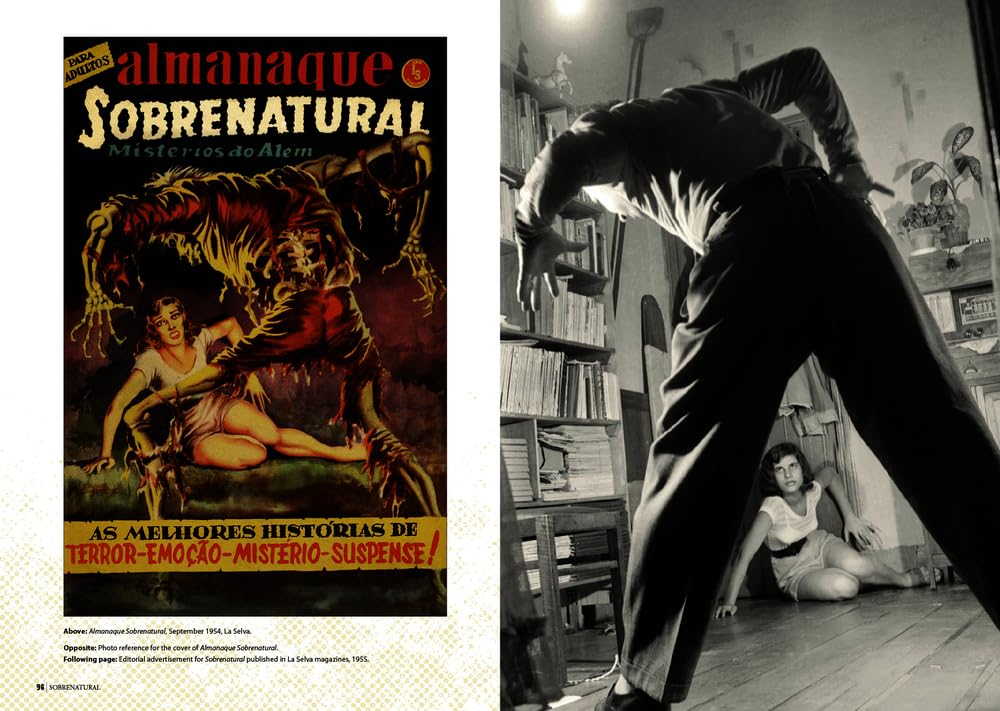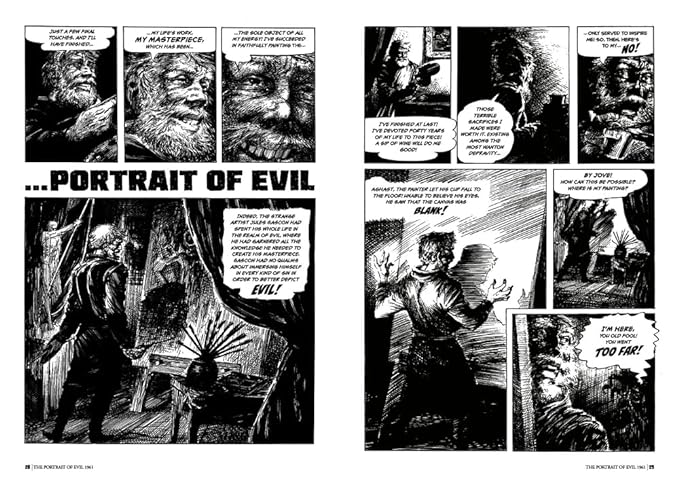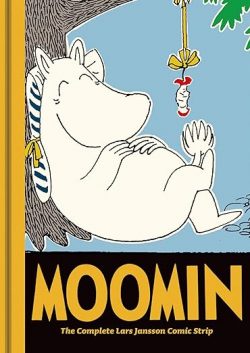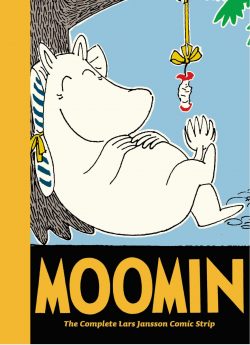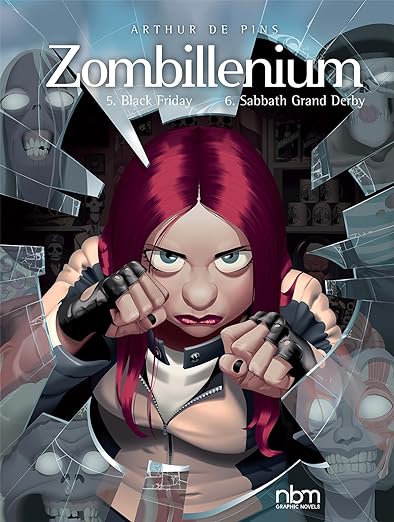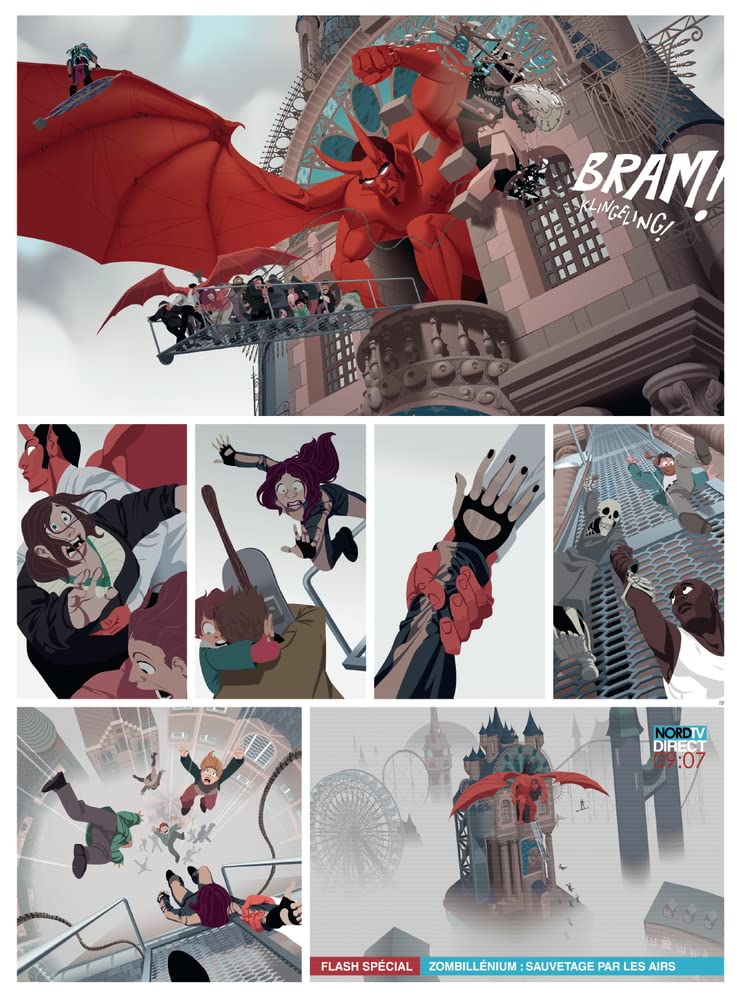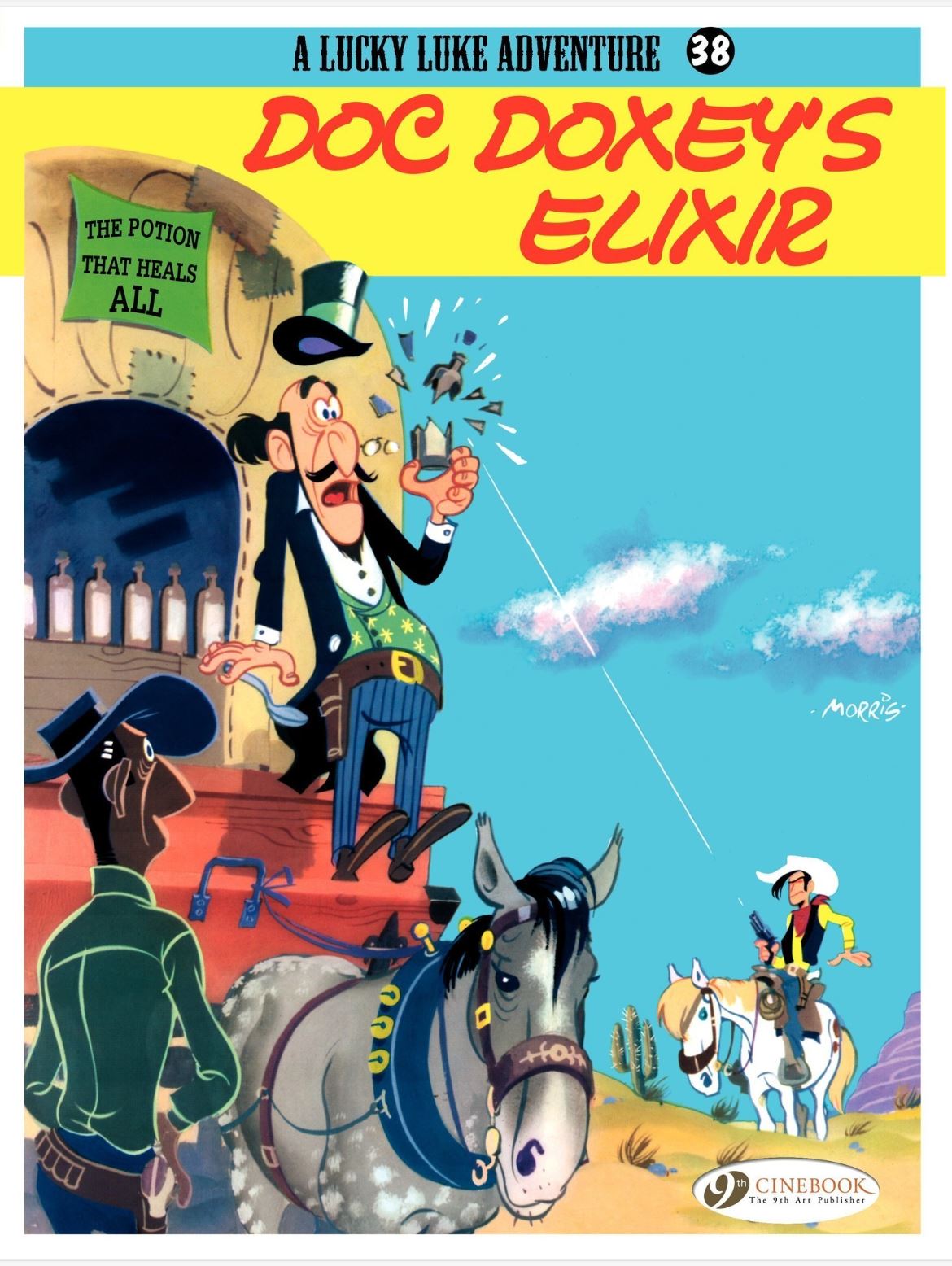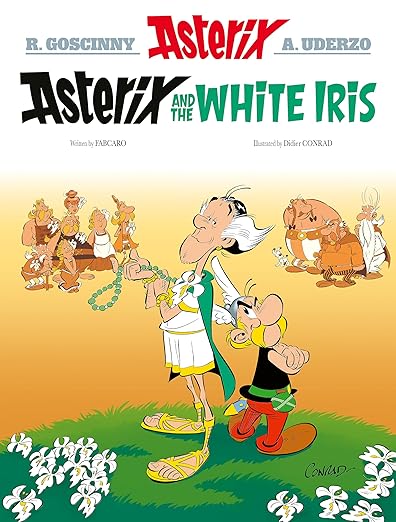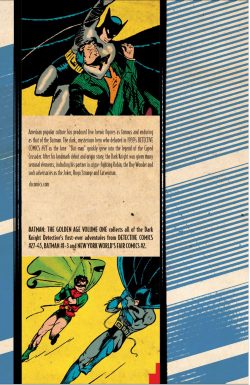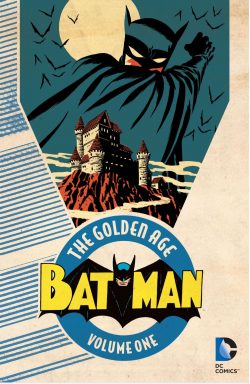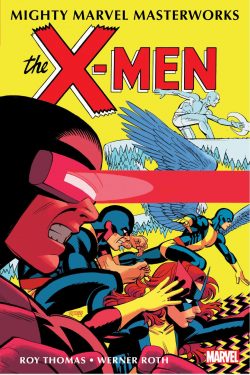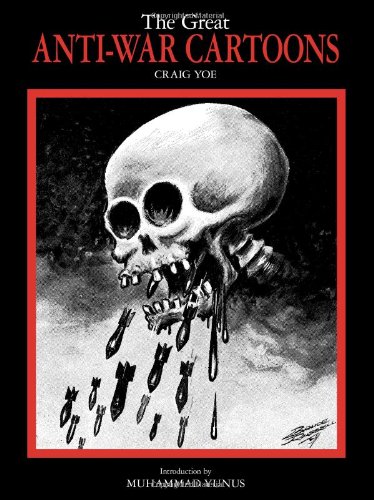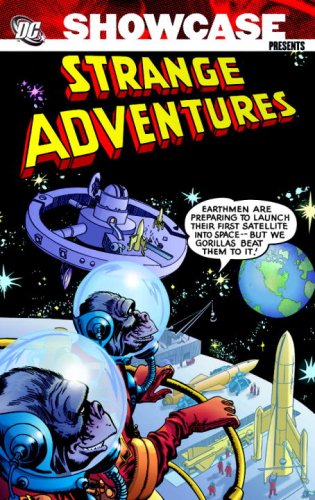
By John Broome, Otto Binder, Edmond Hamilton, Joe Samachson, Gardner Fox, Dave Wood, Bill Finger, Harry Sharp, Sid Gerson, Ed Herron, Jerry Coleman, Gil Kane, Carmine Infantino, Harry Sharp, Sid Greene, Murphy Anderson, Sy Barry, Joe Giella, Jerry Grandenetti, John Giunta, Joe Kubert & various (DC Comics)
ISBN: 978-1-4012-1544-6 (TPB)
As the 1940s closed, masked mystery-men dwindled in popularity and the American comicbook industry found new heroes. Classic genre titles flourished; resulting in anthologies dedicated to crime, war, westerns and horror dominating most comics publishing. These were augmented by newer fads like funny animal, romance and especially science fiction which, in 1950, finally escaped its glorious thud and blunder/ray guns/bikini babes in giant fishbowl helmets pulp roots – as perfectly epitomised in the uniquely wonderful Golden Age icon Planet Comics. It all came about with the introduction of Strange Adventures.
Packed with short adventures from jobbing SF prose writers offering done-in-one dramas and new heroes such as Chris KL99, Captain Comet, The Atomic Knights and more, the magnificent monthly magazine – supplemented a year later by companion title Mystery in Space – introduced wide-eyed youngsters to a fantastic yet intrinsically rationalist universe and all the potential wonders and terrors it might conceal…
This economical monochrome collection (astonishingly, still no archival collections of this stuff available to modern readers these days; not even via that future-fangled interweb) re-presents stories from the inception of the self-regulatory Comics Code: specifically Strange Adventures #54-73 (cover-dates March 1955 to October 1956, right up to the start of the Silver Age when superheroes successfully returned, offering beguiled readers technological wonderment and the sure-&-certain knowledge there were many and varied somethings “Out There”…
On a thematic note: a general but by no means concrete rule of thumb was the Strange Adventures generally occurred on Earth or were at least Earth-adjacent, whilst – as the name suggests – Mystery in Space offered readers the run of the rest of the universe. Moreover, many plots, gimmicks, maguffins and even art and design would be cleverly recycled for the later technologically-based Silver Age superhero revivals…
This mind-blowing, physics-challenging monochrome colossus opens with the March 1955 issue and four classic vignettes, beginning with ‘The Electric Man!’ by John Broome & Sy Barry, wherein a geologist in search of new power sources accidentally unleashes destructive voltaic beings from the centre of the Earth. As always – and in the grand tradition of pulp sci-fi editor John Campbell – human ingenuity/decency generally solves the assorted crises efficiently and expeditiously…
‘The World’s Mightiest Weakling!’ from Otto Binder, Carmine Infantino & Bernard Sachs, offers a charming yet impossible conundrum after a puny stripling gains incomprehensible mass and density during the course of an experiment, whilst ‘Interplanetary Camera!’ (Binder, Gil Kane & Sachs) grants a photographer a glimpse of the unknown when he finds an alien image recorder and uncovers a plot to destroy Earth.
The issue concludes with another Binder blinder in the taut thriller ‘The Robot Dragnet!’, illustrated by Harry Sharp & Joe Giella, with a rip-roaring romp of rampaging robotic rage.
This tale was actually sequel to an earlier yarn but sufficiently and cleverly recapped so that there’s no confusion or loss of comprehensibility…
Issue #55 led with ‘The Gorilla who Challenged the World’ by Edmond Hamilton & Barry, wherein an ape’s intellect is scientifically enhanced to the point where he becomes a menace to all mankind. So great was his threat that this tale also carried over to the next issue…
During this period baffled editors discovered a bizarre truism: any issue of any title which featured gorillas on the cover ALWAYS resulted in increased sales. Little wonder then that so many DC comics had hairy headliners…
‘Movie Men from Mars!’ (Hamilton, Sharp & Giella) sees our world the unwilling location for cinematographers from the Red Planet. Unfortunately, they’re making a disaster movie…
Joe Kubert’s ‘A World Destroyed!’ offered a fanciful yet gripping explanation for how the asteroid belts between Mars and Jupiter were formed, with that cataclysm theme revisited in ‘The Day the Sun Exploded!’ with Broome, Kane & Sachs depicting a desperate dash by scientists to save Earth from melting. Sid Gerson, Murphy Anderson & Giella wrapped up by revealing the baffling puzzle of ‘The Invisible Spaceman!’
SA #56 opened whimsically with ‘The Fish-Men of Earth!’ (Broome, Infantino & Sachs) as air density goes temporarily askew thanks to invading aliens, before ‘Explorers of the Crystal Moon!’ (Broome, Sharp & Sachs) sees a little boy going for a secret solar safari with visiting extraterrestrials.
Artist Paul Paxton then inadvertently becomes ‘The Sculptor Who Saved the World!’ when future-men ask him to make some highly specific pieces for them: a fast-paced yarn by Broome, Kane & Giella whilst penitent Dr. Jonas Mills corrects his evolutionary error by finally defeating his mutated gorilla in the concluding part of Hamilton & Barry’s simian saga ‘The Jungle Emperor!’
Broome, Sid Greene & Sachs’ ‘The Spy from Saturn!’ opened #57 with a Terran scientist replaced by a perfect impostor, prior to ‘The Moonman and the Meteor!’ (Bill Finger & Barry) positing millionaires and aliens trying to buy or inveigle a fallen star from a humble amateur astronomer for the best and worst of reasons. Binder, Kane & Giella proffer ‘The Riddle of Animal “X”!’ as a small boy finds a pet like no other creature on Earth after which Broome, Infantino & Giella reveal an incredible ancient find to a Uranium prospector and some fugitive convicts desperate enough to try any means of escape in ‘Spaceship Under the Earth!’…
Strange Adventures #58 opens with a police chief’s frantic search for a superhuman felon in ‘I Hunted the Radium Man!’ (Dave Wood & Infantino) whilst ‘Prisoner of Two Worlds!’ – Finger & Barry – sees the long-awaited return of genius detective Darwin Jones of The Department of Scientific Investigation. Although an anthology of short stories, the periodical featured numerous returning characters and concepts such as Star Hawkins, Space Museum and others during its run.
Jones debuted in the very first issue, solving fringe science dilemmas for the Federal Government and making 13 appearances over as many years. In this third adventure he assists alien peace-officers in preventing a visiting extraterrestrial taking a commonplace earth object back to his homeworld where it would be a ghastly terror-weapon…
Broome, Kane & Sachs’ ‘Dream-Journey Through Space!’ depicts an ordinary human plucked from Earth to rescue an ancient civilisation from destruction as well as a humble but cunning ventriloquist who saves us all from invasion by invincible aliens in Finger, Greene & Giella’s ‘The Invisible Masters of Earth!’
A young married couple must find a way to prove they aren’t dumb animals on ‘The Ark from Planet X’ (Broome, Greene & Giella) which opened #59, after which ‘The Super-Athletes from Outer Space!’ came to our world to train in a heavier gravity environment and find the galaxy’s greatest sports-coach in a charming tale by Binder, Kane & Sachs. Ed “France” Herron & Infantino then explore the domino theory of cause & effect in ‘Legacy from the Future!’, before Broome & Barry delve into ancient history and doomsday weaponry to discover the secret of our solar system and ‘The World that Vanished!’
SA #60 featured a light-hearted time-travel teaser by Broome, Jerry Grandenetti & Giella concerning historians gathering famous historic personages from ‘Across the Ages!’ before Binder, Kane & Sachs’ ‘The Man Who Remembered 100,000 Years Ago!’ offers terse, tense thrills as lightning provokes ancestral memories of a previous civilisation just in time for a scientist to cancel his unwitting repeat of the self-same experiment which had eradicated them.
Broome, Greene & Sachs then follow the life of a foundling boy who turns out to be an ‘Orphan of the Stars!’, and the issue concludes with a future-set thriller wherein schoolboy Ted Carter wins a place on a multi-species outing to the ‘World at the Edge of the Universe!’ (Binder & Barry).
In #61, ‘The Mirages from Space!’ (Binder, Kane & Sachs) are a portal into a fantastic other world holding the secret of Earth’s ultimate salvation and ‘The Thermometer Man’ – Binder, Greene & Giella – sees a scientist striving to save a stranded Neptunian from melting in the scorching hell of our world. Next, a lighthouse keeper is forced to play smart to counter a Plutonian invasion with ‘The Strange Thinking-Cap of Willie Jones!’ (Herron & Barry).
In conclusion Binder, Greene & Giella’s ‘The Amazing Two-Time Inventions’ has an amateur inventor making fortuitous contact with his counterparts in 3000AD…
Broome, Infantino & Sachs introduced ‘The Fireproof Man’ in SA #62, with his equally astounding dog foiling an alien invasion even as an ordinary handyman falls into another dimension to become a messiah as‘The Emperor of Planet X’ (Broome, Greene & Giella). Binder, Kane & Giella then detail an abortive ‘Invasion from Inner Space!’ before ‘The Watchdogs of the Universe!’ recruit their first human agent in a tantalising tale by Binder, Greene & Giella.
Joe Samachson, Grandenetti & Giella open #63 with ‘I Was the Man in the Moon!’: an intriguing puzzle for an ordinary Joe awakened to find aliens have inexplicably re-sculpted the lunar surface with his face, whilst a Native American forest ranger is Earth’s only hope of translating an alien warning in ‘The Sign Language of Space!’ (Binder, Greene & Giella).
Jerry Coleman, Kane & Giella’s ‘Strange Journey to Earth!’ sees a school teacher deduce an alien’s odd actions and save the world before the issue ends in ‘Catastrophe County, U.S.A.!’ wherein Hamilton, Greene & Giella introduce scientists to the Government’s vast outdoor natural disaster lab…
Sales-boosting simians resurface in #64 as Finger, Infantino & Sachs deliver hostile ‘Gorillas in Space!’ who are anything but, whilst a first contact misunderstanding results in terror and near-death for an Earth explorer lost in ‘The Maze of Mars’ (Binder, Greene & Sachs) and a technological Indiana Jones becomes ‘The Man Who Discovered the West Pole!’ (Binder, Kane & Giella) whilst Samachson & Grandenetti craft a canny tale of planetary peril in ‘The Earth-Drowners!’
For #65 (February 1956) Binder, Greene & Giella’s ‘The Prisoner from Pluto!’ features an alien attempt to warn Earth of imminent Saturnian attack and forced to extreme measures to accomplish his mission. A different kind of cultural upheaval is referenced in quaint-but-clever tale ‘The Rock-and-Roll Kid from Mars!’ (Samachson, Kane & Giella) and a stage mentalist outfoxes genuine telepaths in Binder, Infantino & Sachs’ ‘War of the Mind Readers!’ just before a biologist turns temporary superhero to foil an alien attack in ‘The Man who Grew Wings!’ by Binder, Greene & Giella.
Issue #66 opens with Broome & Infantino’s tale of ‘The Human Battery!’ as an undercover cop suddenly develops incredible power, whilst a guy in a diner mistakenly picks up ‘The Flying Raincoat!’ (Samachson, Greene & Giella) – accidentally averting an insidious clandestine invasion of our world. Binder, Kane & Sachs then see Darwin Jones solve the ‘Strange Secret of the Time Capsule!’ as a metamorphic ‘Man of a Thousand Shapes!’ (Samachson, Infantino & Sachs) proves to have a few secrets of his own…
‘The Martian Masquerader!’ (Strange Adventures #67, by Broome, Kane & Giella) plays clever games as editor Julie Schwartz (AKA “Mr. Black”) is approached by an alien in need of assistance tracking down an ET terrorist, after which Hamilton, Greene & Giella hone in on a subatomic scientist desperate to find his infinitesimal point of origin in ‘Search for a Lost World!’
‘The Talking Flower!’ in chemist Willie Pickens‘ buttonhole is a lost alien who helps him save the world in Samachson, Infantino & Sachs’ charming romance, but the time-travelling travails experienced by archaeologist Roger Thorn after he discovers the ‘Gateway Through the Ages!’ (Hamilton, Greene & Giella) lead only to danger and hard-earned knowledge.
Broome, Infantino & Sachs’ ‘The Man who Couldn’t Drown!’ leads #68: a tale of genetic throwbacks and unfathomable mystery segueing into Samachson, Greene & Giella’s ‘Strange Gift from Space!’ which results in a safer planet for all. A chance chemical discovery then produces a happy salvation in ‘The Balloons That Lifted a City!’ (Samachson, Kane & Giella) and a common thief gets in way over his head after robbing a laboratory in Samachson, Greene & Sachs’ witty ‘The Game of Science!’
SA #69 sees a time-traveller voyage into pre-history and help dawn-age humans overcome ‘The Gorilla Conquest of Earth’ (Broome, Kane & Sachs) whilst the arrival of ‘The Museum from Mars’ (Gardner Fox, Greene & Giella) offers nigh-irresistible temptation and deadly danger to humanity before ‘The Man with Four Minds!’ (Hamilton & Infantino) sees a man with too much knowledge and power eschew it all for normality. ‘The Human Homing Pigeon!’ (Samachson, Greene & Giella) then burns out his own unique gift in the service of his fellows…
‘The Triple Life of Dr. Pluto!’ (Broome, Greene & Giella in #70) deals with the dangers of a human duplicating ray before Darwin Jones confronts a deadly dilemma when warring aliens both claim to be our friends and ‘Earth’s Secret Weapon!’ (Samachson, Kane & Giella). An early computer falls into the hands of a petty thief with outrageous consequences in ‘The Mechanical Mastermind!’ (Samachson & Infantino) whilst Broome, Greene & Giella’s ‘Menace of the Martian Bubble!’ is foiled by a purely human mind and skills of a stage magician.
Issue #71 features ‘Zero Hour for Earth!’ (Broome & Barry) as a scientist at world’s end sends a time-twisting thought-message back to change future history, whilst invisible thieves of our fissionable resources are thwarted by a scientist with unique visual impairments in ‘Raiders from the Ultra-Violet!’ (Binder, Greene & Giella). Writer Ray Hollis sees a star fall and encounters ‘The Living Meteor!’ (Fox, Kane & Sachs) whilst a guy with a weight problem discovers he has become ‘The Man Who Ate Sunshine!’ in a clever conundrum from Samachson, Grandenetti & Giella.
Strange Adventures #72 starts with a fabulous, self-evident spectacular in ‘The Skyscraper that Came to Life!’ by Broome, Greene & Giella, whilst a shooting star reveals an ancient ‘Puzzle from Planet X!’, promising friendship or doom in a classy yarn by Hamilton, Greene & Sachs.
Gerson & John Giunta’s ‘The Time-Wise Thief!’ provides a salutary moral for a bandit with too much technology and temptation before ‘The Man Who Lived Nine Lifetimes!’ (Binder, Kane & Giella) is aroused from a sleep of ages to save us all from robot invasion…
These flights of fantasy conclude with #73: firstly Broome, Greene & Giella’s ‘The Amazing Rain of Gems!’, wherein a sentient jewel almost beguiles the entire world, whilst humans are hijacked to attend a ‘Science-Fiction Convention on Mars’ (Fox, Kane & Giella) and ‘The Man with Future-Vision!’ (Fox, Infantino & Sachs) discovers knowing what’s coming isn’t necessarily enough…
The imaginative inspiration ends with a clever time-paradox fable in Hamilton, Greene & Giella’s ‘Reverse Rescue of Earth!’
Conceived and edited by the brilliant Julie Schwartz and starring the cream of the era’s writers and artists, Strange Adventures set the standard for mind-boggling all-ages fantasy fiction. With stunning, evocative covers from such stellar art luminaries as Murphy Anderson, Carmine Infantino, Gil Kane and Ruben Moreira, this titanic tome is a perfect portal to other worlds and, in many ways, far better times.
If you dream in steel and plastic, are ready for all AI can do and are agonising and still wondering why you don’t yet own a personal jet-pack, this volume might go some way to assuaging that unquenchable fire for the stars!
Then again, so might a spiffy new collection as part of DC’s Silver Age archive strand…
© 1955, 1956, 2008 DC Comics. All Rights Reserved.
